Avoid that grocery store basil and skip the price tags at the garden center by starting your herb seeds from scratch! Herbs are one of the easiest plants to grow from seed. You can get more than enough to clip for your food, harvest for your medicine cabinet, and leave some for the bees. Inside or out, this guide covers everything you need to know about growing herbs from seed.
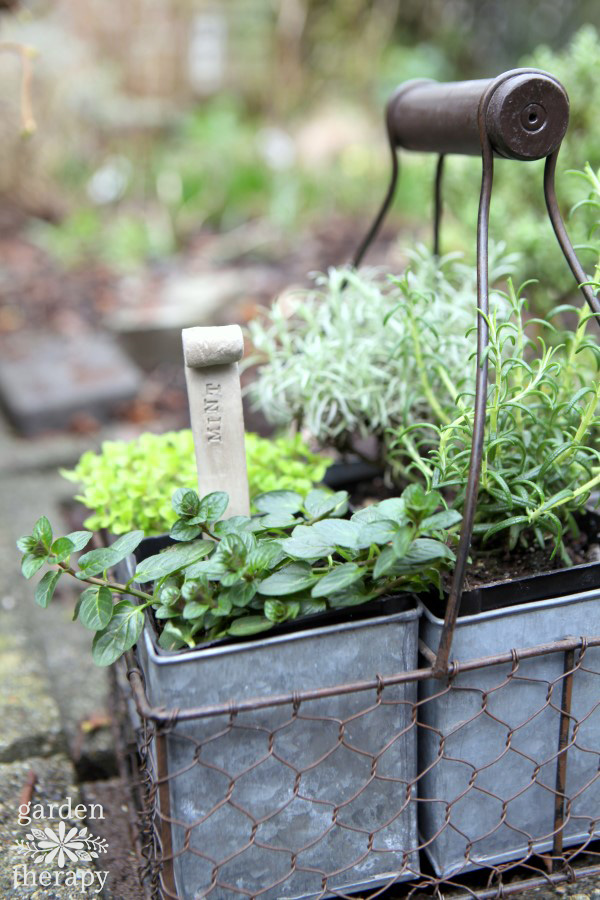
Seeds are where it’s at!!! Yes, you’ll find me buying the odd plant here and there from the garden center (oftentimes when I go to buy one thing, I walk out with 3 plants I didn’t come for). But what you’ll always see me ordering are herb seeds.
The herb garden is by far the largest cultivated area of my garden. I use herbs for cooking, in my beauty recipes, for their medicinal properties, and even as ornamentals. When I grow them from seed, I get better variety, much more bang for my buck, and can start the plants earlier on in the season.
While some herbs can be difficult to start from seed, most of the popular ones aren’t. This means you can get nearly endless amounts of all your favourites like basil, parsley, oregano, dill, mint, and more.
Follow my tips and you’ll be growing herbs from seed in the garden, containers, or indoors in no time!
This post will cover…
- Should You Grow Herbs From Seed in Containers or by Direct Sowing?
- Planting Herbs From Seed With Containers
- Germination
- Transplanting
- Direct Sowing Herbs From Seed Outdoors
- Growing Herbs From Seeds Indoors
- Frequently Asked Questions About Growing Herbs From Seed
- More Posts About Seed Starting
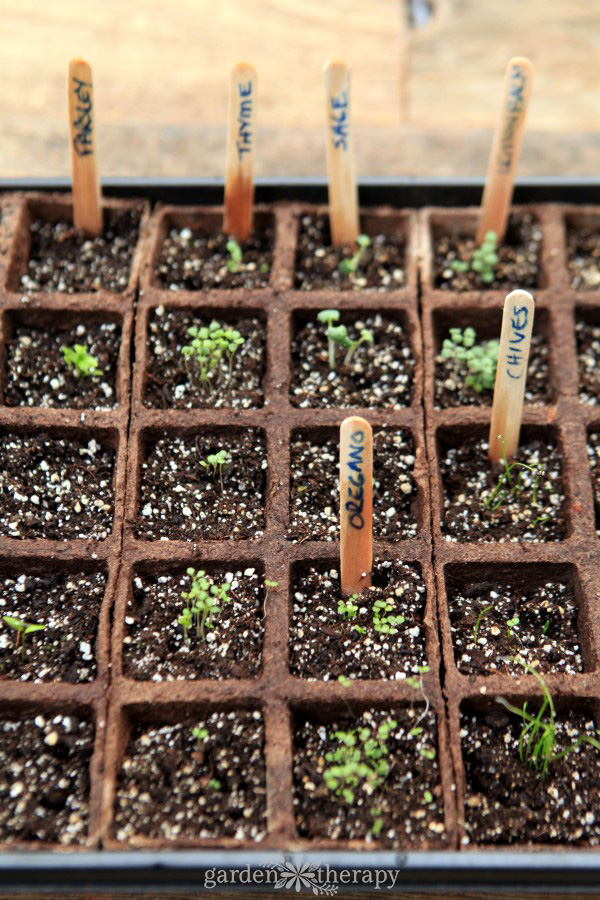
Should You Grow Herbs From Seed in Containers or by Direct Sowing?
When it comes to growing herbs from seed, you’ve got some options! Container gardens allow you to get a jump start on herbs by starting indoors while it’s still wintery outside. You also have complete control over the germination conditions. This is especially helpful for expensive or slow-growing varieties. Slow germinating perennials, for example, should always be started in containers.
Herbs grown in containers will not reach the same full size you would see in the garden. They’re best used for patios, balcony gardens, and indoor culinary herb gardens.
The other option for growing herbs from seed is direct sowing. This is a great method for annual and biennial herbs. In the garden, they will reach their full size. These herbs will also require less maintenance, although you won’t be able to control any of the growing conditions.
When direct sowing herbs, select a good site as that’s where your plant will call home. With proper thinning, you won’t have any need to transplant them later on.
In my garden, I personally do both options. Some plants are just better meant for containers (lemon balm I’m looking at you) and others I would happily let take up residence in the garden. You know your space and herb needs best!
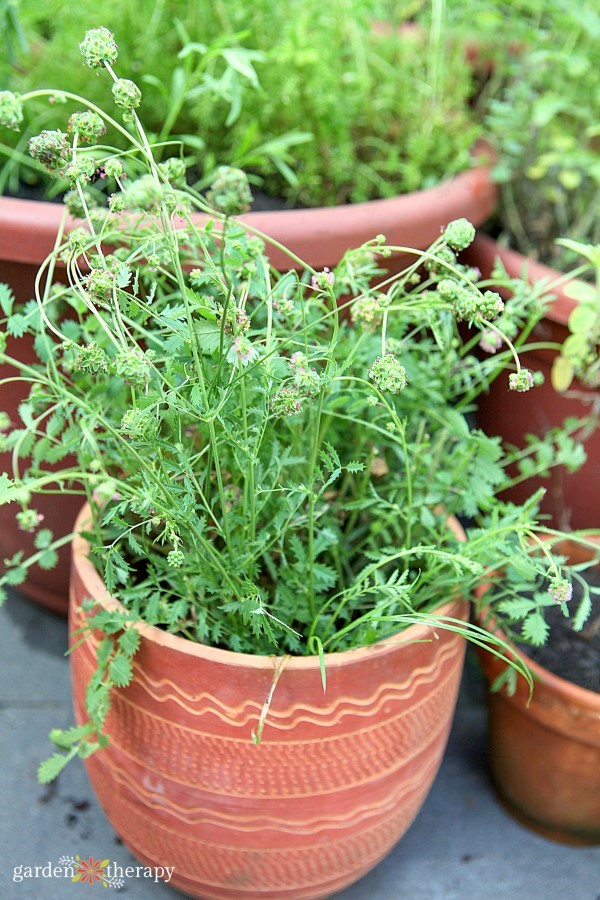
Planting Herbs From Seed With Containers
Even if you don’t plan on keeping your herbs in containers, it’s a great idea to get them started in one. When choosing a container, it doesn’t need to be anything fancy. Wash out a yogurt container, cut a milk carton in half, use pots, seedling trays, etc. Here’s an entire post filled with ideas for seed-starting containers!
Your seed starting soil should be loose, well-draining, hold moisture, and be sterilized from pests and diseases. I recommend making your own soil mixture using one of these DIY soil recipes.
Wet your mixture beforehand and give it a good mix with your hands. Fill your container with soil until it’s about ½ inch from the top. Push your soil down and fill more as necessary.
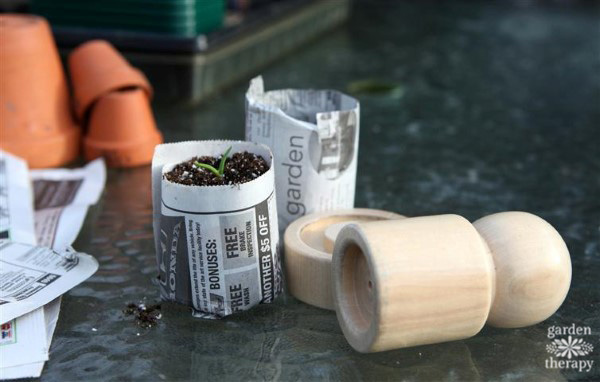
Use your fingertips or a pencil to make holes in the soil for your seeds. In containers, seeds should be buried twice their depth in the soil. Fine seeds should be sprinkled on top and then lightly pushed into the soil. Remember, it’s better to sow thinly than to crowd the seeds.
After sowing, water your herbs. If your container has drainage at the bottom, soak the container in a larger container of water. The water will be drawn upwards and moisten the soil without disturbing the seed placement.
Cover your containers with a clear container to make a mini greenhouse. Alternatively, you can cover them with wet newspaper. One a day, take off the cover for 1-2 hours.
Place your container somewhere warm. Remember, seedlings don’t need sunlight until after germination. If the soil gets dry, mist the soil. Keep it moist but not soaking wet to prevent fungal disease.
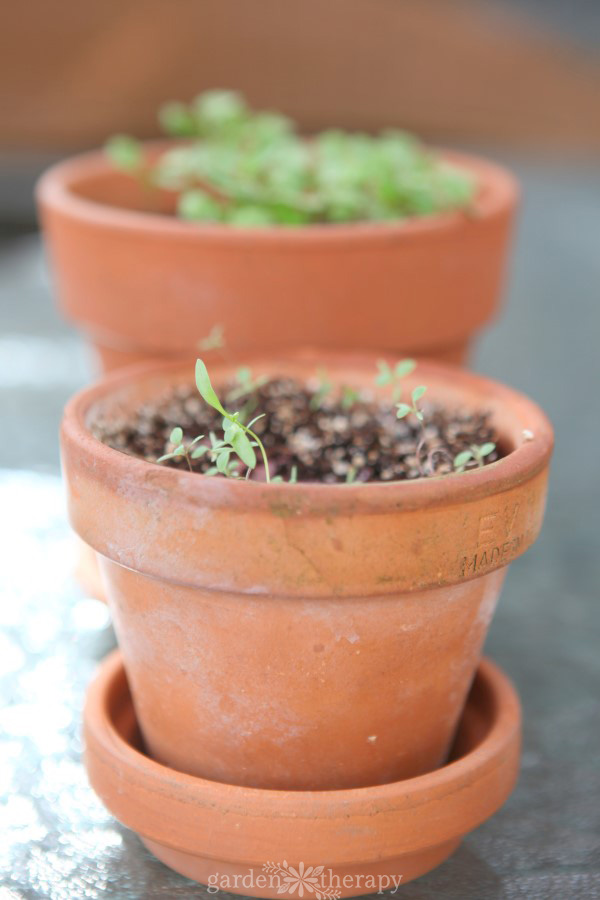
Germination
When the seedlings appear, remove the cover and bring the seedlings somewhere where they will get good light. Be careful not to give them too strong of sunlight or they might burn. Each day, turn the container so that all sides of the seedling get equal amounts of sunlight.
At this stage, damping off is very common. This occurs from too much moisture, overcrowded seedlings, and low temperatures. Don’t oversoak, thin seedlings, and place your seedlings in a warm area to prevent it.

Transplanting
When the seedlings have two sets of true leaves, the plant is ready for thinning or transplanting. If you plan to keep the herbs outside, let the seedlings sit outside for a couple of days before transplanting them.
Transplant the seedlings into bigger containers to give their roots room to grow. Or, place them directly in the garden. Use a pencil to help gently dig the seedlings free. Make sure you don’t plant the seedlings deeper or more shallow than they were before.
Water the plants after transplanting, being careful not to knock them over with their thin and delicate stems.
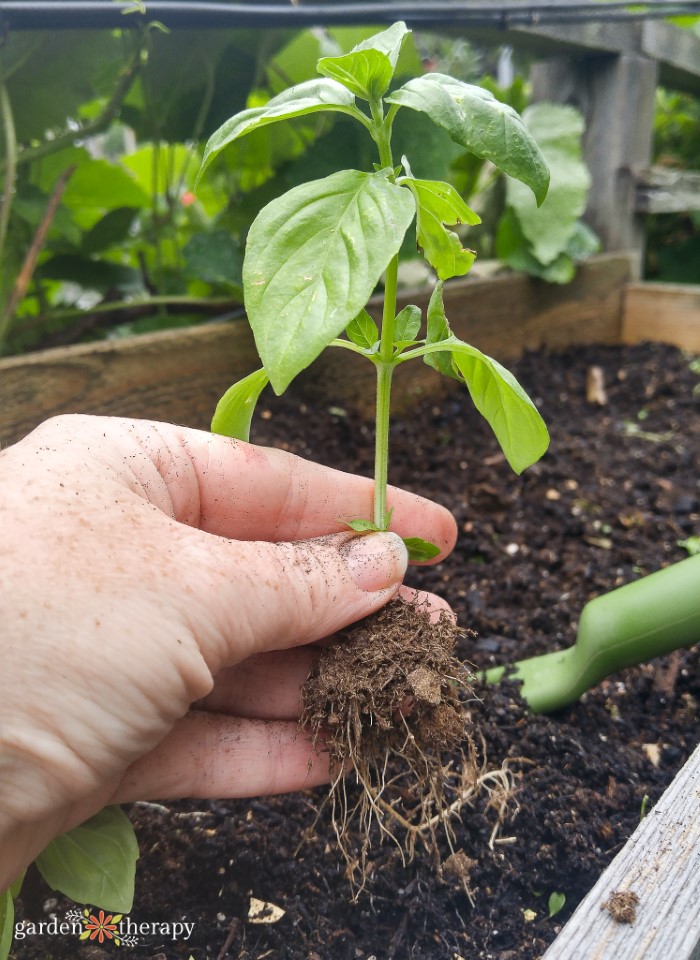
Direct Sowing Herbs From Seed Outdoors
If you feel like skipping the container growing portion altogether, you can direct sow herb seeds outdoors. Herbs aren’t picky when it comes to soil, as long as it drains well. Poor soil will give your more aromatic leaves while richer soil will produce a more abundant plant.
Generally, most herbs prefer sunny locations but check your seed packet for more information about sun preferences for your herb of choice. Add organic matter to the soil. If you have poorly draining soil, you may also want to consider mixing in sand.
Mark your rows 12” apart and create a trench for your seeds to go in. Outside, cover the seeds 3 times their diameter. Make sure not to overcrowd seeds as you spread them in the row. Tiny seeds should not be buried and instead be pressed into the soil.
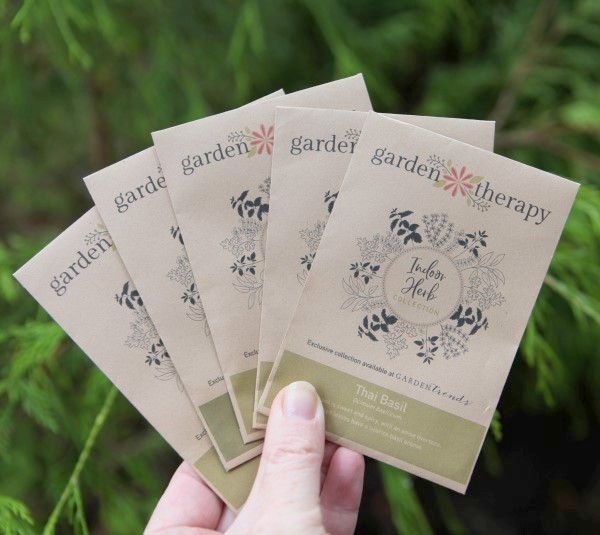
You can also try broadcast seedling where you scatter seeds over your prepared site. This is best for large clumps of herbs rather than rows.
Use the misting setting on your watering wand so you don’t move the seeds while watering. If you’re concerned about hot weather, you can cover the area with burlap to prevent the soil from drying out between waterings.
When the seedlings appear, remove any coverings. When the plants have two pairs of true leaves, they’re ready for thinning. Culinary herbs have flavour immediately so feel free to use those herbs you harvest from thinning!
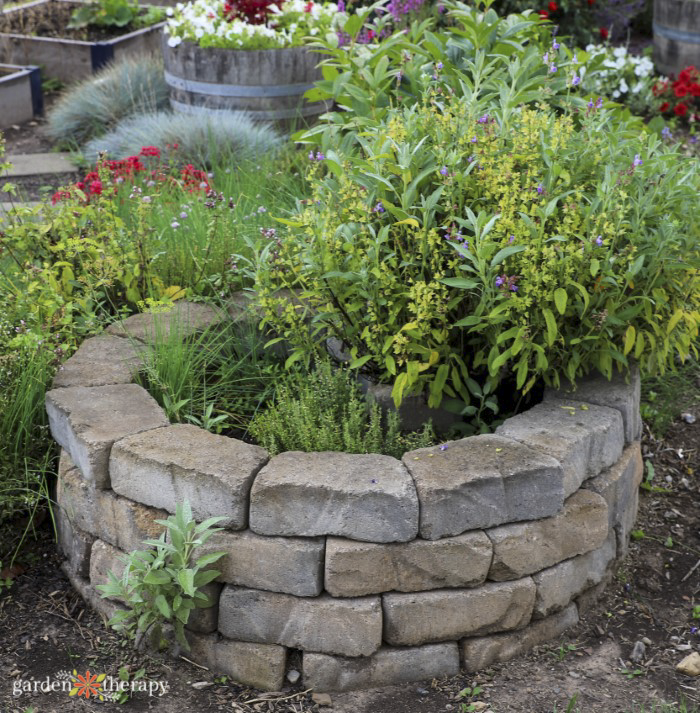
Growing Herbs From Seeds Indoors
Once your seedlings have sprouted from your containers, you can choose to keep them inside. I do this method with both annual and perennial seeds, starting them at different times of the year. You can see my exact indoor herb growing schedule!
Herbs grown indoors tend to become a little leggier as they inch towards the sunlight. I recommend placing your herbs in your absolute sunniest window in the house or under grow lights for 16 hours a day.
Only herbs grown from leaves should be grown inside. Any herbs you want the flowers, seeds, or roots for are better suited for outside.
When it comes to harvesting, don’t harvest too much at once since the growth is constrained both by its container and indoor conditions. This should especially be observed during the slow growth in the winter season.
You can overwinter your tender perennials indoors as well. Learn how to overwinter herbs in this post!

Frequently Asked Questions About Growing Herbs From Seed
This depends on the time of year. Annual herbs grow well from seed, producing leaves quickly and vigorously. You can plant these late in the season no problem. Perennial seeds are slower to grow and need to be started earlier in the season.
Look at the first and last frost dates of your region and the seed packet to see how long it takes for the plant to mature. If your perennial herbs won’t have time to become established before the winter, it’s best to purchase the herb already grown.
Your annual herbs also need time to mature before the first frost if you plant them outside. Otherwise, you can also choose to grow them indoors or purchase the plants.
Both! You can choose to direct sow herbs outdoors after the last frost date. This is best for annuals and biennials. Or you can choose to jump-start your garden by beginning the seedlings indoors. Then you can either transplant them outside to the garden or in bigger containers or choose to keep them inside. Slow-growing perennials should always be started in containers first.
Any plants grown indoors won’t become as large or luscious as they might outside. While indoor herb gardens are very convenient, always choose to grow your herbs in a garden for the most successful plant.
Herbs germinate on average anywhere from 2-15 days. If after 4 weeks you don’t see any growth, the seeds probably won’t germinate. Check your seed packet for a better estimate of germination and maturity times.

Follow these tips for growing herbs from seed and you’ll have a nice herby bounty in no time! Let me know if you have any more questions in the comments down below.

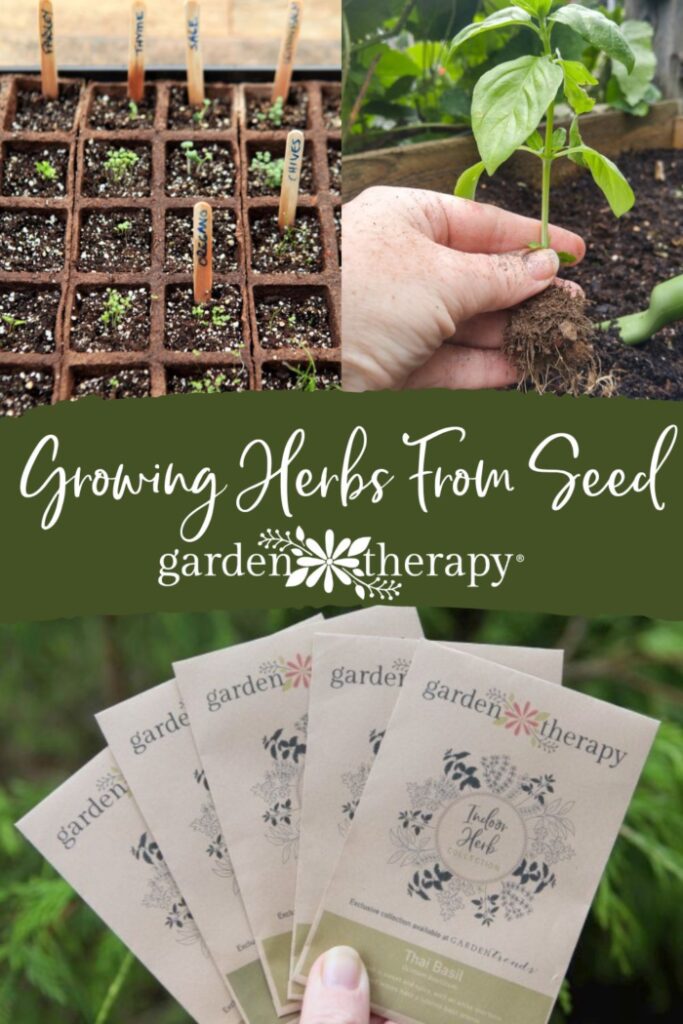



I’d always found coriander difficult until I discovered a trick by mistake when I let a pot of coriander go to seed. The seeds fell into the pot and germinated. Now I always start off my coriander by sprinkling the seed on top of a container of potting compost and keeping it moist and in the sun. It germinates much more easily and faster than if you cover it in the soil.